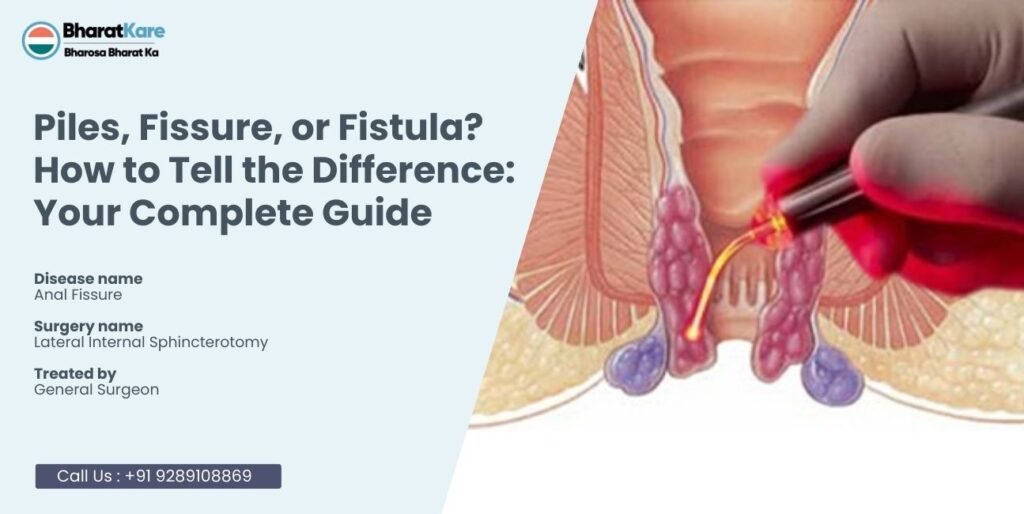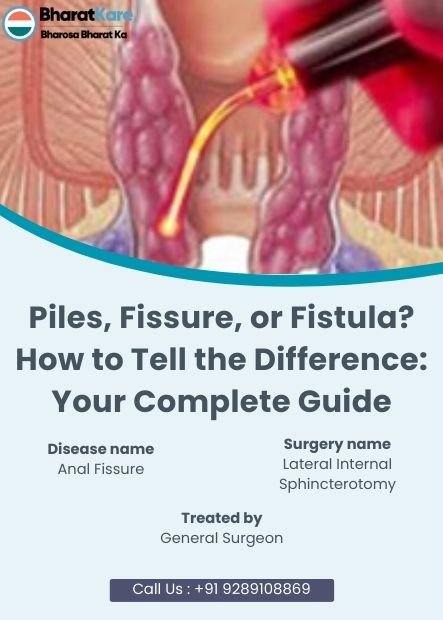Piles, Fissure, or Fistula? How to Tell the Difference - Your Complete Guide
Let me tell you something – after two decades of treating patients with anal conditions, I’ve heard every euphemism in the book. “I have a situation down there,” they whisper. “Something’s not right in my… you know…” they stammer. Look, I get it. Nobody wants to talk about their bottom, but ignoring these symptoms won’t make them disappear.
Just last week, Sarah (not her real name) sat in my office, clearly uncomfortable. She’d been dealing with bleeding and pain for months, convinced she had hemorrhoids because “that’s what Google said.” Turns out, she had an anal fissure that could’ve healed months ago with proper Piles Treatment, Fissure Treatment or Fistula Treatment.
Here’s the thing – piles, fissures, and fistulas are like three cousins who look similar but behave completely differently. Mixing them up is like mistaking a headache for a migraine for a brain tumor. Sure, they all hurt, but the treatment? Totally different ball game.


My Journey into Understanding These Embarrassing Conditions
Twenty-three years ago, fresh out of medical school, I thought I knew everything about hemorrhoids. Boy, was I wrong. My first real education came from Mrs. Rodriguez, a 45-year-old teacher who’d been suffering silently for two years. She taught me that behind every “simple hemorrhoid” case, there’s a real person dealing with pain, embarrassment, and often, misinformation.
That’s when I realized something crucial – most people can’t tell the difference between these three conditions. And honestly? Sometimes even we doctors get it wrong on the first look. But understanding the differences can save you months of unnecessary suffering and inappropriate treatments.
Don’t ignore the discomfort—consult a Piles Treatment, Fissure Treatment or Fistula Treatment. Book your appointment today!
Piles: The Misunderstood Villain
Let’s start with piles – or hemorrhoids, if we’re being fancy. Think of them as your anal canal’s version of varicose veins. You know how some people get those twisted, swollen veins in their legs? Same thing, different location.
I remember treating James, a truck driver who spent 12 hours a day sitting. He came to me with what looked like grapes hanging from his bottom (his words, not mine). “Doc, what the hell is this?” he asked, genuinely scared. Those “grapes” were external hemorrhoids – swollen blood vessels that had pushed through the anal opening.
Here’s what I’ve learned about piles after treating thousands of cases:
- Internal piles live inside your rectum. You usually can’t see them, but they’ll let you know they’re there by bleeding. The blood is typically bright red and painless – like a faucet dripping into the toilet bowl.
- External piles are the drama queens. They hurt, they swell, and they make sitting a nightmare. When they get clotted (thrombosed), patients often think they’re dying. They’re not, but I understand why they feel that way.
What triggers piles? Life, basically. Pregnancy (the baby pushes down on everything), constipation (all that straining), sitting too long (hello, office workers), and sometimes just bad luck with genetics. My grandmother had them, my mother had them, and guess what I discovered during my own colonoscopy last year?
The symptoms that should make you think “piles”:
- Bleeding that doesn’t hurt (usually)
- Itching that drives you crazy, especially at night
- Lumps you can feel (and sometimes see)
- That annoying feeling like you haven’t finished your business
- Mucus that stains your underwear
Modern Piles Treatment, Fissure Treatment or Fistula Treatment for hemorrhoids has come a long way since my early days. I used to send everyone for surgery. Now? Most of my patients get better with simple changes and minor procedures you can do during lunch break.
Anal Fissures: The Paper Cut from Hell
If piles are like varicose veins, fissures are like paper cuts – but paper cuts in the worst possible location. I’ve seen grown men cry from fissure pain. Not kidding.
Mark, a construction worker, described his fissure perfectly: “Doc, it feels like someone’s shoving a razor blade up there every time I poop, and then it burns for hours.” That’s a fissure for you – a tiny tear in the delicate skin lining your anal canal.
The crazy thing about fissures? They’re often triggered by one hard bowel movement. Just one. You’re constipated, you strain, you pass what I call a “torpedo stool,” and boom – you’ve torn the tissue. Then it becomes a vicious cycle: the tear hurts, so you avoid going, which makes you more constipated, which leads to harder stools, which tears the fissure more.
Here’s how to spot a fissure:
- Pain that’s sharp and burning during bowel movements
- Pain that continues for hours afterward (this is key)
- Small amounts of bright red blood on the toilet paper
- You might actually see the tear if you’re brave enough to look
- Spasms in your anal muscle that feel like cramping
Piles Treatment, Fissure Treatment or Fistula Treatment for fissures starts simple – soften those stools and relax that muscle. I’ve seen chronic fissures heal with nothing more than fiber supplements and prescription cream. But chronic ones? Those stubborn little suckers sometimes need a tiny surgical procedure.
Anal Fistulas: The Troublemakers
Now fistulas – these are the complicated cousins. If I had to describe them in simple terms, they’re like unwanted tunnels connecting your anal canal to the skin around your anus.
Lisa’s case stuck with me. She’d been dealing with what she thought was a recurring abscess for eight months. Every few weeks, she’d get a painful lump near her anus that would eventually burst and drain pus. Her family doctor kept giving her antibiotics, but it kept coming back. When she finally came to see me, I found a fistula – a tunnel that kept getting infected because it never properly healed.
Fistulas usually start with an anal abscess. Picture this: bacteria get trapped in a small gland in your anal canal, causing an infection. Your body tries to drain this infection, creating a tunnel to the skin. Sometimes this tunnel heals properly, sometimes it doesn’t. When it doesn’t, you’ve got yourself a fistula.
The telltale signs of a fistula:
- Drainage that never stops (pus, blood, or both)
- Pain that comes and goes as the tunnel fills and drains
- Recurring “abscesses” in the same area
- Fever during flare-ups
- Skin irritation from constant drainage
Unfortunately, Piles Treatment, Fissure Treatment or Fistula Treatment for fistulas almost always means surgery. I’ve never seen one heal completely on its own, though I keep hoping.
How I Actually Tell Them Apart (The Real Doctor Secrets)
After all these years, here’s my cheat sheet for diagnosis:
- If it bleeds but doesn’t hurt much: Probably piles. The blood vessels in hemorrhoids don’t have many pain nerves.
- If it hurts like hell during and after bowel movements: Likely a fissure. That anal sphincter muscle goes into spasm, and it’s agony.
- If it drains constantly and keeps coming back: Fistula territory. They don’t give up easily.
But here’s my honest confession – sometimes I’m wrong on the first look. That’s why I do a proper examination, sometimes with a small scope to peek inside. And occasionally, I need an MRI to map out a complex fistula.
The examination isn’t fun (for either of us), but it’s necessary. I’ve learned to be gentle and talk patients through it. Most people are surprised – it’s not as bad as they imagined.
Don’t ignore the discomfort—consult a Piles Treatment, Fissure Treatment or Fistula Treatment. Book your appointment today!
Treatment: What Actually Works (From My Experience)
The Conservative Approach That Actually Works
Let me be blunt – most patients come to me after trying everything Dr. Google suggested. Coconut oil, essential oils, sitting on tennis balls (yes, really). Some of it helps, most of it doesn’t.
Here’s what I’ve seen work consistently:
- For piles: High-fiber diet (not just supplements – real food), plenty of water, regular exercise, and stopping the straining. I tell patients to spend no more than five minutes on the toilet. Any longer and you’re just creating problems.
- For fissures: Same fiber approach, plus sitz baths that are actually warm (not scalding hot like some websites suggest), and prescription creams that relax the muscle.
- For fistulas: Unfortunately, conservative treatment rarely works. But keeping the area clean and managing pain while waiting for surgery helps.
When We Need to Get Serious
Sometimes conservative treatment isn’t enough. That’s when we move to procedures, and I’ll be honest – they’ve gotten so much better over the years.
For Piles Treatment, Fissure Treatment or Fistula Treatment, I now have options I didn’t have when I started practicing:
- Rubber band ligation for internal piles works great. Takes two minutes, feels like a pinch, and the hemorrhoid falls off in a week. Patients always ask if they’ll see it in the toilet. Sometimes, but it’s just a small piece of tissue.
- Laser treatment has revolutionized how we handle hemorrhoids. Less pain, faster recovery, and patients can usually go back to work the next day.
- For stubborn fissures, a tiny injection of botulinum toxin (yes, Botox) can work wonders by relaxing that spastic muscle. Sounds weird, but it works about 80% of the time.
- Fistula surgery is where things get complex. Each fistula is different, and the surgery has to be tailored accordingly. The goal is always to close the tunnel without affecting bowel control.
The Real Talk About Prevention
You know what I tell every patient? Prevention is boring but effective. After seeing thousands of these cases, here are the patterns I’ve noticed:
People who rarely get these problems:
- Eat lots of fruits and vegetables (not just supplements)
- Drink water throughout the day
- Exercise regularly (doesn’t have to be intense)
- Don’t strain on the toilet
- Don’t sit on the toilet reading novels
People who keep coming back:
- Live on processed food
- Are chronically dehydrated
- Sit all day without moving
- Strain during bowel movements
- Ignore their body’s signals
I had one patient, David, who came back three times for Piles Treatment, Fissure Treatment or Fistula Treatment before he finally changed his diet. Once he started eating real food and walking daily, his problems disappeared. I haven’t seen him in my office for five years.
Why I Partner with BharatKare
Speaking of comprehensive care, I’ve been working with BharatKare for several years now, and they’ve impressed me with their approach to Piles Treatment, Fissure Treatment or Fistula Treatment. What I like about them is they don’t just focus on the procedure – they actually care about the whole patient.
I remember referring Mrs. Patel to them for a complex fistula repair. Not only did they handle the surgery expertly, but they also provided detailed post-operative care instructions in her native language and followed up with her regularly. That’s the kind of comprehensive care that makes a real difference.
Their use of advanced techniques, combined with genuinely affordable pricing, means I can refer patients without worrying about them skipping treatment due to cost. Too many people suffer unnecessarily because they can’t afford proper care.
When to Actually Worry (Red Flag Symptoms)
Look, I don’t want to scare you, but there are times when you need to stop reading blogs and get to a doctor immediately. Call 911 or go to the ER if you have:
- Heavy bleeding that won’t stop
- Severe pain with fever (could be a serious infection)
- Sudden inability to control your bowels
- Any new symptoms if you’re over 50
I’ve seen patients delay seeking help for serious conditions because they were embarrassed. Don’t be that person. We’ve seen it all, trust me.
The Lifestyle Changes That Actually Matter
After treating these conditions for over two decades, I’ve noticed that patients who make these specific changes rarely come back:
- The morning routine that works: Start with a glass of water, eat something with fiber (real fruit, not just juice), and take a 10-minute walk. This simple routine prevents more problems than any medication I can prescribe.
- The toilet rule: No phones, no books, no magazines. Get in, do your business, get out. Your bathroom isn’t a library.
- The stress connection: I’ve noticed that patients going through stressful periods (divorce, job loss, family illness) often develop these problems. Stress affects everything, including your bowels.
What’s New in Treatment (The Exciting Stuff)
The field keeps evolving, and honestly, some of the new treatments amaze me. Piles Treatment, Fissure Treatment or Fistula Treatment options now include:
- Laser hemorrhoidoplasty – sounds fancy, but it’s essentially using laser energy to shrink hemorrhoids from the inside. Less pain, faster recovery.
- Platelet-rich plasma for fissure healing – we take your own blood, concentrate the healing factors, and inject them into the fissure. Science fiction becoming reality.
- 3D imaging for fistula mapping – now I can see exactly where these tunnels go before surgery, making the procedure more precise and safer.
The Support System You Need
One thing I’ve learned is that having these conditions can be isolating. Patients often feel like they’re the only ones dealing with “embarrassing” problems. They’re not.
I always tell my patients about support groups and online communities where people share real experiences with Piles Treatment, Fissure Treatment or Fistula Treatment. Sometimes hearing from someone who’s been through the same thing is more valuable than any medical advice.
Following Up: Why It Matters More Than You Think
Here’s something most patients don’t realize – the follow-up visit is often more important than the initial treatment. That’s when I can catch problems early, adjust treatments, and make sure healing is progressing properly.
I’ve seen too many patients skip follow-ups because they feel better, only to have problems recur months later. Piles Treatment, Fissure Treatment or Fistula Treatment doesn’t end when the symptoms disappear – it ends when healing is complete and we’ve addressed the underlying causes.
My Final Thoughts (After 23 Years of This)
If there’s one thing I want you to take away from this, it’s this: these conditions are common, treatable, and nothing to be ashamed of. I’ve treated CEOs and cashiers, teachers and truck drivers, teenagers and grandmothers. Anal problems don’t discriminate.
Piles Treatment, Fissure Treatment or Fistula Treatment has advanced tremendously. We have better understanding, better techniques, and better outcomes than ever before. But the most important factor in successful treatment isn’t the procedure – it’s getting proper diagnosis and starting treatment early.
Don’t suffer in silence. Don’t rely on Dr. Google. And for heaven’s sake, don’t let embarrassment prevent you from getting help.
Your bottom deserves better than guesswork and home remedies. Whether you need Piles Treatment, Fissure Treatment or Fistula Treatment, there are experienced professionals ready to help you get back to living comfortably.
Ready to take control of your health? Stop wondering and start healing. Schedule a consultation with a qualified proctologist today. Your future self – the one sitting comfortably without pain or embarrassment – will thank you. And if you’re looking for comprehensive, affordable care, consider reaching out to specialists like those at BharatKare who combine expertise with genuine patient care.
Remember: you’re not just treating a condition – you’re reclaiming your quality of life. That’s worth every bit of temporary discomfort during treatment.
FAQ
FAQs About Piles Treatment, Fissure Treatment or Fistula Treatment: Answering Your Most Common Queries
BharatKare is a specialized healthcare provider mentioned by the author as a trusted partner. They focus on comprehensive and affordable treatment for anal conditions like Piles (Hemorrhoids), Fissures, and Fistulas. Based on the doctor's account, they are known for using advanced techniques, providing thorough patient care (including post-operative support and multilingual instructions), and making specialized treatment accessible.
While painless, bright red bleeding is the most common symptom of internal hemorrhoids (piles), it should always be evaluated by a doctor. Other, less common conditions can also cause similar bleeding. The key takeaway is that this symptom is highly suggestive of piles, but a proper medical examination is crucial for an accurate diagnosis and to rule out other issues.
Many acute (recent) anal fissures can and do heal on their own with conservative treatment, such as a high-fiber diet, increased water intake, warm sitz baths, and avoiding straining. However, if the fissure becomes chronic (lasting more than 8 weeks), the muscle spasm prevents healing, and medical intervention like prescription creams or minor procedures (e.g., Botox injection) is often required. Surgery is typically a last resort for the most stubborn cases.
This is a very common and important concern. The primary goal of modern fistula surgery is to eliminate the fistula tract while preserving the anal sphincter muscles that control bowel function. With advanced techniques like laser surgery and precise 3D mapping mentioned in the article, skilled surgeons can minimize the risk to these muscles. The risk is higher with complex fistulas, which is why seeing an experienced specialist is critical.
The article strongly advises against prolonged self-diagnosis and treatment. A good rule of thumb is: if symptoms (like pain, bleeding, or a lump) persist for more than a week, or if they are severe from the onset (heavy bleeding, intense pain, fever), you should see a doctor immediately. Delaying a professional diagnosis can allow a simple condition to become chronic or complicate the treatment.
Quick Links
Popular Surgeries
Find Us
© Copyright BharatKare 2025. All Right Reserved.


